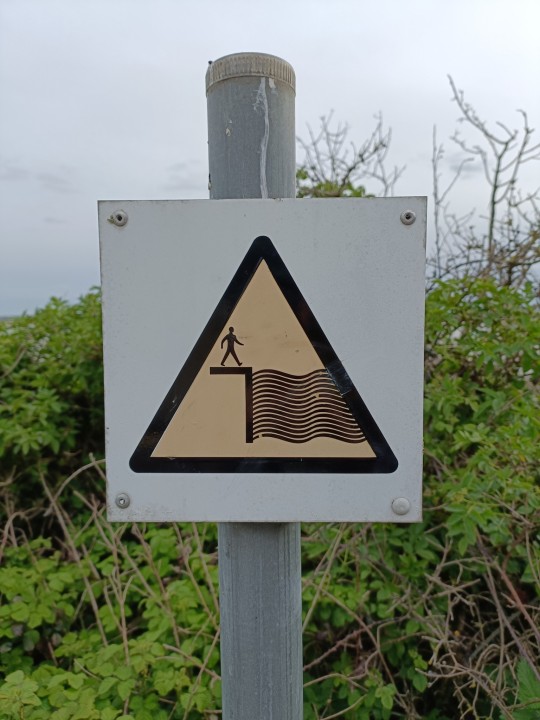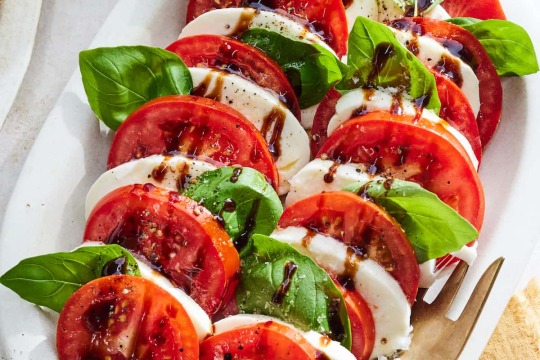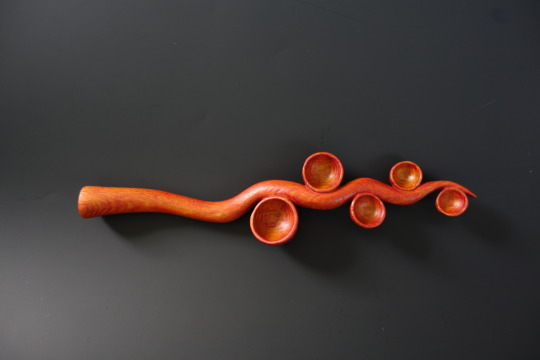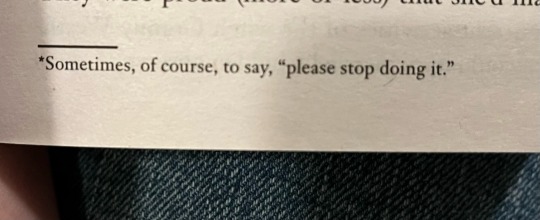Note

This is a nice sign to look at. 10/10 for composition.
he looks so confident
8K notes
·
View notes
Text
You guys really liked my last poll so
12K notes
·
View notes
Note
Hello. Tell me, please, have you ever practiced Goetia magic? If so, how does it work? I am grateful to you in advance.♥️
Ah, the demons. Nope! Unless it involves sticking stuff directly into the dirt or setting things on fire, it's not usually of interest to me. I think @/cryptotheism has an intro to the occult dissection on patreon, but I couldn't even tell you for certain what it might contain or how easy it actually is to peruse. This is something you'll have to pursue on your own, I'm afraid. Grab an annotated copy of the Lesser Key of Solomon and start reading!
Good luck!
93 notes
·
View notes
Text
check out literally just sitting outside if u can. the hobby of the summer
63K notes
·
View notes
Text
30K notes
·
View notes
Text
Consider this: Caprese as a wealth/money spell.

(photo for reference)
93 notes
·
View notes
Text
can someone please be proud of me like fuck I’m trying
2M notes
·
View notes
Text
can someone please be proud of me like fuck I’m trying
2M notes
·
View notes
Text
can someone please be proud of me like fuck I’m trying
2M notes
·
View notes
Text
Ambient Spells
The idea of the ambient spell isn’t so uncommon. My use of the word “ambient” may throw you for a bit of a loop. An ambient spell is any spell that permeates a space in an unobtrusive way. They affect the area surrounding their vessel and require little to no maintenance or upkeep. They’re long-term workings that require varying levels of effort to put together and cast. Depending on what exactly you need, they can be as simple as setting out a bowl of salt or as complex as crafting a home decor piece from scratch.
I always recommend making ambient spells that are self-fueling. I often refer to them also as “set it and forget it” spells. They’re the crockpot of spellwork — work up front for a slow burn output.
Chances are that you’re already aware of or even know how to create ambient spells. Any spell that affects the vibe of a room, for example, would count as an ambient spell. Lighting incense specifically to invite in positive energy counts. A ward that sucks up baneful magic and transforms it into blessings also counts. The primary idea of an ambient spell is that it’s making a change to your environment in the background. It’s the cool breeze in summertime, the subtle piano at a fancy restaurant, the scent of fresh-baked cookies fading as the day goes by. Positive, but not overt.
When to Use (or Not Use) an Ambient Spell
By their nature, ambient spells are fairly general workings. They can be quite powerful, of course, just like any other spell. The thing to keep in mind is that they’re not ideal for targeted magic.
For example, I wouldn’t create an ambient spell to banish someone from my life. I might make an ambient spell to make an area unwelcoming to them, or to anyone who would do me harm. The unwelcoming vibe might discourage them from coming around, sure. But it may not work outside of the area the spell lives in; and it may not get rid of them for good.
Similarly, an ambient spell might make a good general ward for keeping out loud, unwelcome spirits, but it wouldn’t specifically cast out the one particular spirit who’s been causing problems. It might discourage their behavior, but it wouldn’t necessarily get rid of them. A concentrated, single-use banishing spell would work significantly better for that purpose. Afterwards, an ambient spell can keep the area clear of that spirit’s influence.
I also wouldn’t use an ambient spell to draw in specific success. General success or money, absolutely — whatever wants to come my way is welcome, via a basic money bowl set up next to my wallet. But if I specifically want a promotion or a particular amount of money, I’m not going to leave that to the ambient money spell. I would craft a spell specifically for what I’m looking for.
When deciding what kind of spell to cast, keep this idea in mind. An ambient spell is best for behind-the-scenes results that happen without your concentrated effort. When you want something specific, a more targeted spell will work better nine times out of ten.
Creating an Ambient Spell
It’s possible to create an ambient spell with nothing but energy work. However, I often find that these fade quickly and don’t lend themselves well to self-fueling. They tend to need more active upkeep than I prefer for a spell that’s meant to be set and let go. I recommend choosing an appropriate vessel of some kind to contain the spell to help it last longer.
How do you decide what’s an appropriate vessel, though? And how do you set one up? How do you make a spell self-fueling? Let’s start from the top and go in order.
Identify the Purpose
Decide what the spell will do. This is going to define the components and the way you’re going to cast the spell.
In my experience, ambient spells work best when they’re given a single purpose. For example, I wouldn’t make a spell that’s a ward and a cleanser and a spirit welcome mat. It dilutes the purpose. Choose a single, clear motive for the spell.
Choose a Vessel
Now that you know what your spell will do, it’s time to decide what it’s going to look like. The vessel you choose should reflect the spell’s purpose in some way.
An open bowl works well for absorbing energy. Why? It’s open. The face of it is open to the room, ready to take in whatever kind of energy you assign to its contents.
A closed jar, on the other hand, would be good for repelling. It’s closed off and sealed — a one-way road going out of the jar and into the room to clear it.
A wreath hung at the door could serve a lot of purposes, depending on what it’s made with. I would use a wreath as an agent of transformation or as an energy emitter to release a certain energy into the space.
A stone makes a solid vessel for protection or grounding. I have one on my working altar to help keep me in the moment and create a good environment for working magic.
When you’re choosing your spell vessel, keep in mind how visible you want it to be. Certain vessels are going to naturally be more obvious than others. A wreath, for example, is hard to miss — but it also just looks like nice home decor. A jar full of herbs and things would be more obviously a spell, but they can be small and easily hidden.
I have both obvious and hidden ambient spells peppered around my home for varying purposes. If you’re keeping your practice a secret, you’ll likely want to keep your spells more obscure or hidden. But if you aren’t, and you can make the choice of whether you want the spell to be in plain sight or not, consider the effect you want the spell to have.
If you want the spell to absorb bad vibes, baneful magics, the evil eye, or other negativity, a hidden spell might serve you well. Hiding the vessel somewhere means that whoever’s casting against you may not expect the resistance. On the other hand, if you want a vessel that allows friendly spirits to visit you during the holidays, a beautiful centerpiece on your dining table that’s charmed with spirit-friendly magic might serve the purpose.
Choose an Energy Source
Ambient spells need to draw energy from somewhere. Think of it like a battery. The ingredients you put into the spell may provide a temporary charge, but if you want the spell to be long-term, it needs an input. How will your spell recharge itself?
If you want the spell to be shorter-term, only a few days or so, then you can skip this step. But if you want an ambient spell to last a while, like a ward or vibe-adjuster, you’ll need to think about this carefully.
Like when choosing the vessel, the energy source should match the purpose of the spell. For example, I have a simple room refresher spell set on a table that’s central to my home. The purpose of it is to take anxiety and negative thoughts to turn them into positivity. I set it up so that the act of walking past the bowl swirls the air around it, and therefore also the energy around it. That kinetic energy fuels the bowl’s magic and keeps it going. I don’t have to actively recharge the bowl or its contents, because we walk past it constantly.
Another example would be an ambient spell to help you do the dishes. (Whether that’s remembering to do them or finding the motivation for it is up to you.) The fuel for the spell could be the act of walking into or past the kitchen, running water elsewhere in the home, or even cooking or eating.
The energy source could also be something like lighting a candle next to or over the vessel on a schedule, if you prefer. This would add an upkeep step, of course, and wouldn’t be my first choice. The only ambient spell I do this with is my money bowl, and that’s because it’s tuned to be able to shift focus from day to day depending on what exactly I need (commissions versus tips versus discounts, etc.).
Setting Up an Ambient Spell
Decide where you want to place your spell’s vessel ahead of time. If you have pets or kids, make sure you put whatever it is out of their reach. If the vessel is something like an uncovered bowl, you’ll want to be sure that it isn’t going to get knocked over. Similarly, if it’s made of glass, you don’t want it to fall and shatter. If your vessel needs to be hidden somehow, determine where you’ll keep it. It would be smart to make note of where the spell is and what it looks like in your grimoire or spell notebook just so that if you forget about it, you can identify it later on down the road.
After you know where you want to put it, it’s time to choose ingredients and fill your vessel. The components you decide on should, obviously, match your goals.
Casting an ambient spell is much the same as casting a regular spell. The only thing to keep in mind is that an ambient spell has a sort of prolonged release.
Upkeep and Care of an Ambient Spell
For the most part, ambient spells should require little to no upkeep. With that said, you should still do routine check-ups on them. I include them in my regular rounds when I check on my wards and various protections, but you could do yours whenever it makes the most sense to you.
Depending on how you decided to fuel your spell, you may need to do a bit of feeding. Whether that’s lighting a new candle, refilling a cup of water, mixing around a pile of herbs, or giving the vessel a little shake, do so anytime it feels like the spell’s energy is flagging. It may take some practice in sensing energy to know exactly when a spell needs refueling. This is partly why I suggest creating a schedule to check in on the spell; ambient spells are a great type to practice sensing spell energy, since they’re typically long-lasting and may wax or wane depending on the day.
If your spell is fully self-fueling and it doesn’t seem to be working anymore (or at all, even from the start), it’s time to take it apart. Discard disposable components according to your practice’s tenets. Cleanse the rest for future use. I would suggest washing your spell vessel alongside magical cleansing.
A Ready-to-Use Example
Here’s an extremely simple example of an ambient spell I use in my home to keep the main living area light, fresh, and conducive to getting work done. Since both my partner and I work from home, it’s important that our areas have an aura of focus.
Materials:
- A small bowl, preferably green or brown
- Enough salt to fill the bowl halfway
- A few pinches of dried rosemary
Instructions:
1. Ensure the bowl is clean and dry. Pour salt into the bowl until it’s halfway full.
2. Sprinkle dried rosemary into the salt and stir.
3. Instruct the spell, in whatever way makes sense to you, to exude focused but calm energy into the space.
4. Place the bowl in an area that is frequently trafficked.
5. Leave the bowl in place until it no longer provides a fresh, focused energy to the space. Dispose of the contents, clean the bowl, and reset the spell.
Notes:
- This spell is powered by movement specifically, because both my partner and I work from home, and we pace when we’re having a hard time focusing. The spell draws in the energy from our pacing and the frustration we’re putting out to fuel itself. It then transforms and releases the energy as calm, focus, and productivity.
- I suggest a green or brown bowl because this spell is meant to work for our jobs. Green for success, brown for grounding. Personally, my bowl has both colors.
- When instructing the spell, you can speak to the bowl, write a petition, do an incantation, or whatever else you like. This is the most personal part of the spell, and it’s what makes the thing Go. It’s up to you to decide how it’s going to work.
Final Thoughts
I would hesitate to call ambient spells “low energy” spellwork. While they can be low-energy-friendly in the long run, and they can be extremely simple to set up (such as the one I described above), they aren’t always. Ambient spells do require an up-front energy cost. Even so, I find them very rewarding and useful.
Folks who visit my home often comment that it’s an inviting, friendly, good-natured space where they can leave their worries and anxieties behind. That’s on purpose. I’ve got ambient spells in place that eat up anxiety and spit out positivity. I’ve got ones that repel hexes and are charged by sunlight. All of these spells are long-lasting and well worth the effort it took to create them.
I hope this little guide is useful to you! If you’ve got questions, feel free to send me an ask. I’m happy to ramble about ambient spells or other types of magic as much as you’d like.
And if you did enjoy this post, consider dropping a couple dollars in my tip jar! Supporters of all types (tips, commissions, shop purchases, and memberships) get early access to posts like this, sometimes up to two weeks early, and every bit helps me keep the lights on.
238 notes
·
View notes
Text


'Spoon Tree' wooden spoon carved in Lacewood.
38 notes
·
View notes
Text
Me when I add literally anything to my altar:

578 notes
·
View notes
Text
blows my mind that i have little online friends who mildly care about me. it’s really nice
143K notes
·
View notes
Text
So what I’ve learned from the past couple months of being really loud about being a bi woman on Tumblr is: A lot of young/new LGBT+ people on this site do not understand that some of the stuff they’re saying comes across to other LGBT+ people as offensive, aggressive, or threatening. And when they actually find out the history and context, a lot of them go, “Oh my god, I’m so sorry, I never meant to say that.”
Like, “queer is a slur”: I get the impression that people saying this are like… oh, how I might react if I heard someone refer to all gay men as “f*gs”. Like, “Oh wow, that’s a super loaded word with a bunch of negative freight behind it, are you really sure you want to put that word on people who are still very raw and would be alarmed, upset, or offended if they heard you call them it, no matter what you intended?”
So they’re really surprised when self-described queers respond with a LOT of hostility to what feels like a well-intentioned reminder that some people might not like it.
That’s because there’s a history of “political lesbians”, like Sheila Jeffreys, who believe that no matter their sexual orientation, women should cut off all social contact with men, who are fundamentally evil, and only date the “correct” sex, which is other women. Political lesbians claim that relationships between women, especially ones that don’t contain lust, are fundamentally pure, good, and unproblematic. They therefore regard most of the LGBT community with deep suspicion, because its members are either way too into sex, into the wrong kind of sex, into sex with men, are men themselves, or somehow challenge the very definitions of sex and gender.
When “queer theory” arrived in the 1980s and 1990s as an organized attempt by many diverse LGBT+ people in academia to sit down and talk about the social oppressions they face, political lesbians like Jeffreys attacked it harshly, publishing articles like “The Queer Disappearance of Lesbians”, arguing that because queer theory said it was okay to be a man or stop being a man or want to have sex with a man, it was fundamentally evil and destructive. And this attitude has echoed through the years; many LGBT+ people have experience being harshly criticized by radical feminists because being anything but a cis “gold star lesbian” (another phrase that gives me war flashbacks) was considered patriarchal, oppressive, and basically evil.
And when those arguments happened, “queer” was a good umbrella to shelter under, even when people didn’t know the intricacies of academic queer theory; people who identified as “queer” were more likely to be accepting and understanding, and “queer” was often the only label or community bisexual and nonbinary people didn’t get chased out of. If someone didn’t disagree that people got to call themselves queer, but didn’t want to be called queer themselves, they could just say “I don’t like being called queer” and that was that. Being “queer” was to being LGBT as being a “feminist” was to being a woman; it was opt-in.
But this history isn’t evident when these interactions happen. We don’t sit down and say, “Okay, so forty years ago there was this woman named Sheila, and…” Instead we queers go POP! like pufferfish, instantly on the defensive, a red haze descending over our vision, and bellow, “DO NOT TELL ME WHAT WORDS I CANNOT USE,” because we cannot find a way to say, “This word is so vital and precious to me, I wouldn’t be alive in the same way if I lost it.” And then the people who just pointed out that this word has a history, JEEZ, way to overreact, go away very confused and off-put, because they were just trying to say.
But I’ve found that once this is explained, a lot of people go, “Oh wow, okay, I did NOT mean to insinuate that, I didn’t realize that I was also saying something with a lot of painful freight to it.”
And that? That gives me hope for the future.
146K notes
·
View notes



